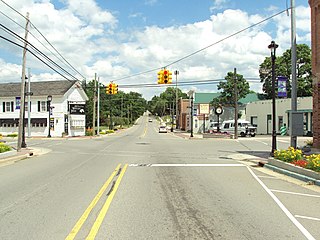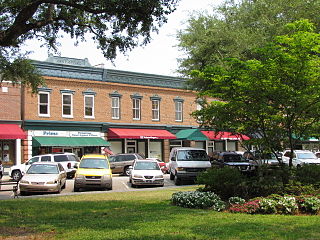
Edgefield County is a county located on the western border of the U.S. state of South Carolina. As of the 2010 census, its population was 26,985. Its county seat and largest city is Edgefield.

Edgefield is a town in Edgefield County, South Carolina, United States. The population was 4,750 at the 2010 census. It is the county seat of Edgefield County.

Laurens is a city in Laurens County, South Carolina, United States. The population was 9,139 at the 2010 census. It is the county seat of Laurens County.

Tabby Manse, also known as Thomas Fuller House, is a building in Beaufort, South Carolina.

Waccamaw River Warehouse Historic District is a national historic district located at Conway in Horry County, South Carolina. It includes three contributing buildings: a steamer terminal, warehouse, and tobacco warehouse. These buildings illustrate the evolution of utilitarian structures at the end of the 19th century, documenting the shift from heavy-timber braced-frame structural members to smaller-member, balloon framing with multiple diagonal bracing and the use of a clerestory for additional light. They are the last extant warehouses in Conway associated with the commercial trade on the Waccamaw River.

White Church, also known as The Brick Church, and formally as St. Thomas Episcopal Church and St. Thomas and St. Dennis Parish Church, is a historic church north of Cainhoy in Berkeley County, South Carolina.

The Metamora Crossroads Historic District is a historic district centered at the intersection of Oak and High Street in the small village of Metamora in Metamora Township in Lapeer County, Michigan. It was designated as a Michigan State Historic Site and also added to the National Register of Historic Places on July 19, 1984.

The Walnut Hill Historic District is a collection of 40 family dwellings, agricultural outbuildings, and other structures and sites associated with the Walnut Hill Plantation and the Mial-Williamson and Joseph Blake farms near Shotwell, North Carolina. The historic district represents the post-Civil War growth of one of the largest agricultural centers in Wake County. It is situated primarily along the northeast end of Mial Plantation Road between its intersections with Major Slade and Smithfield Roads.

The Burton Commercial Historic District is located in Burton, Texas.

Summerville Historic District is a national historic district located at Summerville, Dorchester County, South Carolina. The district encompasses 700 contributing buildings in the village of Summerville. About 70 percent of the buildings predate World War I. The buildings include raised cottages, Greek Revival influenced, and Victorian / Queen Anne and other turn of the 20th century structures are found throughout. In addition to residential structures, the district includes churches and commercial buildings—most dating from around 1900. Notable buildings include Tupper's Drug Store, O. J. Sire's Commercial Building, White Gables, Pettigru-Lebby House Gazebo, Summerville Presbyterian Church, Wesley United Methodist Church, and the Squirrel Inn.

Johnston Historic District is a national historic district in Johnston, Edgefield County, South Carolina. The district encompasses 127 contributing buildings, 16 contributing sites, 1 contributing structure, and 1 contributing object in the village of Johnston. The district includes commercial and residential properties from approximately 1880 to 1920. They are in a variety of popular architectural styles such as Italianate, Second Empire, Victorian, Queen Anne, and Neo-Classical. The district also includes three churches and the town's cemetery. The railroad, which passes through Johnston, was the primary cause for the creation of the town and continues to be a reminder of the town's early transportation history. Notable buildings include the Johnston Depot, Western Carolina Bank, H. W. Crouch Building, Bank of Johnston, Crouch-Halford House, and Johnston First Baptist Church.

Edgefield Historic District is a national historic district located at Edgefield, Edgefield County, South Carolina. The district encompasses 33 contributing buildings, 6 contributing sites, and 1 contributing object in the town of Edgefield. The buildings center on the landscaped village green, and includes forty 19th century buildings, three of which are house museums. There are a number of 19th century Greek Revival style homes, while others are noted for beautiful Federal style fanlights and unusual doorways. Other district properties include Victorian influenced homes and downtown commercial buildings. Five churches represent the Georgian, Victorian Gothic, and modified Gothic architectural styles. Notable buildings include the Edgefield County Courthouse, Trinity Episcopal Church and Rectory, St. Mary's Catholic Church, Halcyon Grove, Oakley Park, Carroll Hill, Blocker House, Yarborough House, and Padgett House.

Ridgeway Historic District is a national historic district located at Ridgeway, Fairfield County, South Carolina. The district encompasses 31 contributing buildings in the town of Ridgeway. A majority of the buildings in the district were built between 1890 and 1915, the heyday of cotton production in the area. The district includes a commercial block with a predominance of simply ornamented two-story brick stores and a residential block with primarily asymmetrical, frame, weatherboarded houses lining the tree shaded streets. Styles include Queen Anne, Neo-Classical, Victorian, and Bungalow. Notable buildings include the J. Spann Edmunds House, Augustus Talley Moore House, Thomas Co. Store, Ruff Furniture Store, Dobson's Drug Store, Ridgeway Town Hall, Ruff's Gin Shop, James Team's Drugstore, and the Charlotte and South Carolina Railroad House.

St. Julien Plantation is a historic plantation complex located near Eutawville, Orangeburg County, South Carolina. The plantation house was built about 1854, and is a two-story, L-shaped, vernacular farmhouse with Italianate influences. It features a low-pitched hipped roof with projecting eaves and a bracketed cornice. Also on the property are the contributing log cotton warehouse, board and batten kitchen, Carpenter Gothic mule barn, smokehouse, garage, storage building, and several wood frame farm buildings.

Buffalo Mill Historic District is a national historic district located at Buffalo, Union County, South Carolina. The district encompasses 190 contributing buildings and 2 contributing structures associated with the Buffalo Mill textile mill complex and mill village. The mill complex includes the main mill, mill office, power house, ice factory, mill warehouse, company store, and company bank/drug store. The main mill building features applied stylized Romanesque Revival detailing. The mill village housing varies from large, free-classic, Queen Anne style supervisor's houses, to shingle-style bungalows, to simple, one-story, workers residences. The village also includes a school and a baseball field/park.

Hill Complex Historic District is a national historic district located at Sharon, York County, South Carolina. It encompasses four contributing buildings in Sharon. The buildings are commercial, industrial, and residential buildings built by William Lawrence Hill between about 1890 and 1925. The buildings are the William L. Hill House, W. L. Hill Cotton Gin, W. L. Hill Cotton Warehouse and Dock, and the separately listed W.L. Hill Store (1913).

West End Commercial Historic District is a national historic district located at Greenville, South Carolina. It encompasses 15 contributing buildings in Greenville's second "downtown." The commercial buildings primarily date from about 1880 to 1920, and include examples of Victorian commercial architecture. Notable buildings include the American Bank, Alliance and Mills & McBayer Cotton Warehouses, Indian River Fruit Store, Pete's Place, Bacot's West End Drug Store/Stringer's Drug, Furman Lunch, and Greer Thompson Building.

Glencoe Mill Village Historic District is a national historic district located at Glencoe, Alamance County, North Carolina. It encompasses 48 contributing buildings and 6 contributing structures built between 1880 and 1882 in Glencoe.

Tarboro Historic District is a national historic district located near Tarboro, Edgecombe County, North Carolina. The district encompasses 364 contributing buildings in central Tarboro. It includes a variety of industrial, commercial, residential, and institutional buildings dating from the late-18th through early-20th centuries. Located in the district are the separately listed Tarboro Town Common, The Barracks, Redmond-Shackelford House, Pender Museum, Blount-Bridgers House, Coates-Walston House, Calvary Episcopal Church and Churchyard, and the Cotton Press complex. Other notable buildings include the Morris-Powell House, Porter House, U. S. Post Office (1914), Pippen House (1870s), Dancy-Battle-Bass Clark House, Holderness House, Howard Memorial Presbyterian Church (1908-1909), W. H. MacNair House (1913), Henry Cherry-George White House, Jones House (1870-1875), Tarboro Primitive Baptist Church, St. James Methodist Church (1916), Carolina Telephone & Telegraph (1912), Clark's Warehouse #1 and #2, Battle-Porter-Powell House, Gaskil1-Hussey House (1882), Cheshire-Nash House, and Norfleet Court (1858).

Hawkins Avenue Historic District is a national historic district located at Sanford, Lee County, North Carolina. It encompasses 200 contributing buildings and 4 contributing structures in a predominantly residential section of Sanford. The district includes notable examples of Colonial Revival and Queen Anne style architecture, with buildings largely dated between about 1900 to the 1930s. Located in the district is the separately listed Sanford High School, Former. Other notable buildings include the John McIver House (1880s), Duncan E. McIver House (1893), Malcolm D. McNeill House, E.L. Gavin House (1922), First Presbyterian Church of Sanford (1914), First Baptist Church (1925), the former Sanford Cotton Mill complex, and the Liles Bonded Cotton Warehouse.























